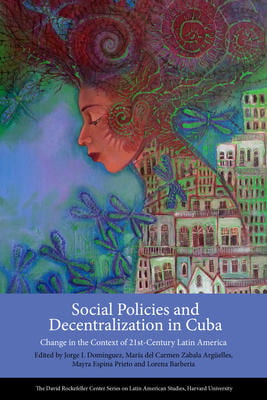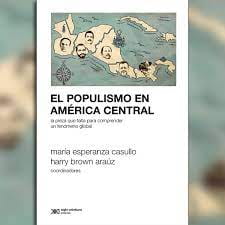A Review of Social Policies and Decentralization in Cuba
Social Policy in Cuba: Across the Great Divides

Social Policies and Decentralization in Cuba: Change in the Context of 21st-Century Latin America, edited by Jorge I. Domínguez, María del Carmen Zabala Argüelles, Mayra Espina Prieto, and Lorena G. Barberia David Rockefeller Center Series on Latin American Studies, Harvard University, 2017, 272 pages
From my snapshot views of Cuba in visits over the years, two eye-opening moments stand out. In 1980, after visiting one workplace after another where union and management representatives explained how no con ict existed between labor and management under socialism, I stumbled on a heated open-air labor-management negotiation in Santiago that was rapidly degenerating into a shouting match. In 2003, co-leading a participatory community workshop in Havana, I was startled to hear a government representative identify the biggest obstacle to community development as “the bureaucracy.” Both moments speak to the continuing inequalities of power and resources in socialist Cuba.
In fact, I would suggest a Cuban-U.S. volume on social policy in Cuba like this one must engage at least five great divides. The first is the rapidly growing income inequality in that country, which has exploded since the Soviet Union collapsed and discontinued its economic support of Cuba. That inequality is most starkly visible to natives and visitors alike in the disjunction between the dollar and peso economies. The second is the gap in power and opportunities between Havana and the rest of the country. A third divide, found in Cuba as in most countries, is the distance between the Cuban state and its people embodied in top-down policies and limited opportunities for bottom-up input. Collaboration between Cuban and U.S. researchers entails two other divides. One is simply differing perspectives across the two countries. A U.S.-Cuban analysis must also contend with the sharply polarized views of Cuba’s government and its policies within each country and more broadly in the world.
Social Policies and Decentralization in Cuba is the latest in a series of DRCLAS books from an ongoing research project on social and economic change in that country. The authors make a strong case that the policy terrain has shifted significantly in recent years, making this new addition not just an update but an exploration of new policy processes. The chapters spotlight individual sectors (enterprise development, education, health care, environmental policy, remittances) and processes of participation and decentralization, as well as framing these in-depth looks with an overview and two chapters on social policy in the broader Latin American context.
Viewing the book as a whole, what do we learn about Cuban social policy? First, we learn that in ways analogous to broader shifts across Latin America and the world, Cuba has shifted from universal subsidies and services toward more targeted programs—while maintaining universalist ideals about access to health care, education and economic opportunity. Second, the authors point out the ways in which formal universalist policies can fall short at the implementation level in the context of limited and unequally distributed resources. Some chapters address disparities in outcomes, some underscore disparities in access to benefits and services, some touch on both—and some avoid the issue altogether—but taken as a whole the essays make this point repeatedly and effectively. These observations are particularly salient in a Cuban context in which resources have become both more limited and more unequally distributed since 1990. A third lesson: there has been significant movement away from centralized, top-down policy implementation. This glass is definitely half-full, but that marks an important advance from the Cuba I first saw four decades ago.
The book’s editors and authors gamely take on the five great divides—in ways that are distributed unevenly across the ten chapters. Growing inequality by class, perhaps Cuba’s most consequential social shift in its last three decades, and continuing inequality by gender and race, take center stage in María del Carmen Zabala’s chapter on participatory community development projects and the papers on education and employment (Dayma Echevarría and Mayra Tejuca), health care (Susset Fuentes), and remittances (Lorena Barbería). The findings are most detailed on gender, thinnest on race, given Cuba’s omission of race from of cial statistical surveys, but form a fascinating composite picture. Perhaps most interesting are the convoluted ways in which class plays out in contemporary Cuban society: access to remittances, for example, or access to better health care via social connections or economic bribes.
The economics of the Havana/hinterlands divide is, disappointingly, under-reported in the book, but the politics of that divide, and the related state-citizenry divide, come in for close examination. The two strongest chapters in the volume, papers on policy decentralization by Geydis Elena Fundora and Mayra Espina, offer clear-eyed assessments of the promise and risks of decentralization, and the barriers to local initiative that remain in place. The two chapters offer two very different vantage points, both valuable: Fundora reports on the views regarding various aspects of participation expressed by key informants from government, the academy and communities; the core of Espina’s chapter is a review of seven concrete decentralization initiatives, in a set of mini-case studies of policy. Each chapter is packed with concrete discussion of steps forward and continuing limitations and barriers in breaking down these two potent gaps and moving toward broad channels of voice and participation. My “glass half-full” image at the outset of this review is based on these two rich chapters.
Zabala’s essay on local participation and a chapter on nonfarm cooperatives by Reynaldo Jiménez and Niurka Padrón also touch on the state-citizen divide. Like Fundora and Espina, Zabala tells us how policy is implemented on the ground, in this case, through community development projects. However, Zabala primarily explores what dimensions of inequality get recognized and addressed within these projects; she is silent on the relationship of these NGO-based projects and processes with the state. Jiménez and Padrón’s paper falls short in a more basic way: their analysis is limited to description of a series of laws and statistics on cooperatives.
The U.S.-Cuban dynamic plays out in interesting ways in this volume. Cubans authored the bulk of the book, seven out of ten chapters. But Harvard- and DRCLAS-linked scholars wrote the three chapters that are positioned to frame the book: Jorge Domínguez’s introduction, and closing chapters by Lorena Barberia and Soledad Artiz that place Cuba in the wider Latin American mosaic.
In the Cuban academy, there are limits to the extent of acceptable criticism of the Cuban government and its policies—Fidel Castro’s dictum of “within the Revolution, everything; against the Revolution, nothing” remains in force, though the definition of what is “within” has expanded somewhat. The Cuban authors have dealt with these limitations in different ways. Fundora and Espina have written chapters full of critique, but the critique comes via the voices of informants and of other researchers who have evaluated specific programs. Zabala, as noted above, largely avoids mention of the state. Jiménez and Padrón (on cooperatives), Echevarría and Tejuca (on education), and Marta Rosa Muñoz (on environmental policy) thread the needle by giving statistical summaries of outcomes and lists of laws and policies, but with little or no evaluation how policies are linked to outcomes, nor assessment of the strengths and weaknesses of the policies (though Echevarría and Tejuca chapter do offer a bit more). As a result, though these three chapters are useful resources on the contours of policy and key outcomes, I found them arid and ultimately frustrating reading.
The Harvard-linked authors who sit outside Cuba face a different set of incentives and constraints, and it shows. This is especially true in Domínguez’s introduction, which offers a blunt, though not unsympathetic, assessment of Cuba’s serious social and economic problems, and of the achievements and shortcomings of the country’s evolving mix of social policies. Barberia takes the same road as Fundora and Espina, citing research that exposes the mixed impacts (ameliorating poverty, but intensifying inequality) of the current system of remittances in Cuba. Artiz’s chapter provides interesting data on Latin American public opinion regarding social policy, but misses the opportunity to use this analysis to think through Cuban social policy in light of Latin American experiences.
Are Cuba’s social policies adequate to overcome Cuba’s great divides? The evidence from this book says not yet, but there is some room for optimism in Cuba’s continuing commitment to egalitarian ideals and its continuing process of policy experimentation. For me, at least, that is indeed a glass half full.
Winter 2018, Volume XVII, Number 2
Chris Tilly, professor of Urban Planning at UCLA, studies bad jobs and how to make them better, and the role of social movements in economic change. Though not a Cuba scholar, he has visited Cuba in 1979, 1980, 1994, and most recently twice in 2003.
Related Articles
A Review of Born in Blood and Fire
The fourth edition of Born in Blood and Fire is a concise yet comprehensive account of the intriguing history of Latin America and will be followed this year by a fifth edition.
A Review of El populismo en América Latina. La pieza que falta para comprender un fenómeno global
In 1946, during a campaign event in Argentina, then-candidate for president Juan Domingo Perón formulated a slogan, “Braden or Perón,” with which he could effectively discredit his opponents and position himself as a defender of national dignity against a foreign power.
A Review of Aaron Copland in Latin America: Music and Cultural Politics
In Aaron Copland in Latin America: Music and Cultural Politics, Carol Hess provides a nuanced exploration of the Brooklyn-born composer and conductor Aaron Copland (1900–1990), who served as a cultural diplomat in Latin America during multiple tours.




